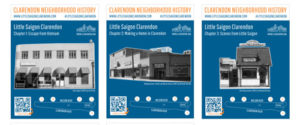Public Art and Oral Histories Honor Clarendon’s Vietnamese Heritage
On May 9, 2015, artist Khánh H. Lê’s temporary public installation will be on display in the fountain of Clarendon Central Park for “Echoes of Saigon,” a multimedia celebration honoring the journey of Clarendon’s Vietnamese community during the late 1970’s and 1980’s.
In addition to the public art installation, Echoes of Saigon will include hands on art activities, music, a walking tour led by former community members, a County Board proclamation, special guest speakers, other displays, and the Lemongrass Food Truck.
Following the May 9 event, the artwork will move to the Center for Local History at Central Library.
About the Artist and Installation
This artwork draws on primary sources to highlight the history of Little Saigon – the thriving hub of Vietnamese commerce and social activity that existed in Clarendon in the late 1970s and ‘80s. Similar to his work for the mobile gallery Art on the ART Bus, Lê has created a mixed media townscape, embedded with memories of an ethnic enclave that no longer exists.
Lê has reproduced photographs by Michael Horsley, who documented Little Saigon during its heyday, to create structures that resemble individual businesses that existed. The buildings further tell the stories of Little Saigon through the inclusion of audio components that play excerpts of recent oral history interviews with former Little Saigon community members. The interviews were conducted by graduate students from Urban Affairs & Planning in Virginia Tech’s School of Public & International Affairs.
Commissioned by Arlington Public Art, the installation also includes a sculptural apricot blossom tree and folded paper boats that come together to form flowers, symbolizing the journeys of Vietnamese immigrants who left their homeland to create a new community in Clarendon and a new life in America.
About “Echoes of Little Saigon”
In the fall of 2014, Arlington County’s Historic Preservation Program and the Center for Local History collaborated with graduate students from Virginia Tech’s Department of Urban Affairs & Planning to explore ways to document, preserve, and celebrate the cultural heritage and diversity of Arlington. One of the resulting projects focused on the enclave in Clarendon once known as Little Saigon. The students conducted oral histories with members of the Vietnamese community who immigrated to Arlington during the 1970s and ‘80s, and those who shopped at or owned the many Vietnamese restaurants and businesses that existed in Clarendon during that time. The students also provided recommendations for increasing awareness about Little Saigon and recognizing the contributions of the Vietnamese community to Arlington.
Inspired by the students’ work, County staff and volunteers have continued to collaborate with community members, Virginia Tech professor Dr. Elizabeth Morton, and her students Judd Ullom and Carlin Tacey to organize today’s event honoring Clarendon’s Vietnamese heritage and to launch a Little Saigon Smartphone tour created by Judd Ullom.
County staff, local artists, students, and members of the region’s Vietnamese American community are continuing to explore other ways to commemorate and raise awareness about the contributions of Little Saigon to Arlington’s cultural heritage. Future goals include creating a permanent historic marker to honor this history.
For additional information, and to access the Little Saigon Smartphone tour, visit www.littlesaigonclarendon.com.

Not sure this economic factor has been addressed: the refugees’ arrival coincided with Metro
construction, tearing up the streets of Clarendon and causing hardship to established small retailers there. With reduced rents and even vacancies during Metro construction, new Vietnamese arrivals had some unique opportunities to gain a foothold in starting a business. This entrepreneurialism then providing job opportunities for other refugees
working in a new but culturally familiar context.
Hi Paul,
Yes, many of the oral histories discussed exactly that. You can see excerpts of the oral histories at http://littlesaigonclarendon.com/living-museum/.